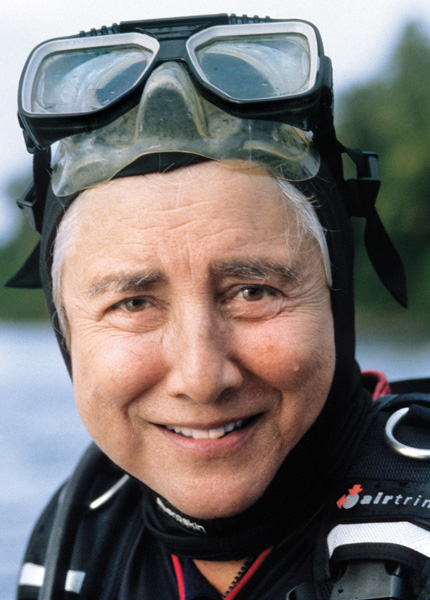alumni profile
A Life Under the Sea
Eugenie Clark / GSAS ’46, ’50
by Renée Alfuso / CAS ’06
The tale of how Eugenie Clark fell in love with the ocean reads like The Little Mermaid in reverse. Once upon a time, a then 9-year-old Clark spent each Saturday watching the fish and tiger sharks at the aquarium in New York’s Battery Park, while her widowed mother worked at a cigar and newspaper stand in the lobby of the nearby Downtown Athletic Club. Clark longed to be part of the sharks’ world. “I used to put my nose as close to the glass as possible and pretend that I was under the sea with them,” she says. “I thought, ‘Someday I’d like to dive with them.’ ”
More than 5,000 dives later, Clark, known as “the Shark Lady,” is a world-renowned ichthyologist who was inducted into the International Scuba Diving Hall of Fame earlier this year. Throughout her 60-year career studying deep-sea sharks and tropical fishes, she’s received numerous awards, including the Explorers Club Medal for her extraordinary lifetime contributions in exploration and scientific research. She’s discovered more than a dozen new species of fish, written three books and more than 170 articles, and taught for 32 years at the University of Maryland, College Park. Although officially retired since 1992, Clark hasn’t slowed down. She travels frequently for lectures, conferences, and expeditions—and nothing can keep her out of the water.
In fact, at 88, it’s easier for Clark to dive than it is to walk; the water’s buoyancy frees her of her hip problems and the cane she uses. This past summer, she went cage diving in South Africa with Great Whites, which she calls “white sharks”—as though they’re not the man-eating monsters from Jaws. “I don’t feel you even need cages if you know how to handle the sharks,” Clark says. (The closest she’s come to being bitten was when she hit her car brakes and the mounted tiger shark jaws in the passenger seat drew blood from her arm as she reached out to brace it.) She’s always been too intrigued by sharks to be scared of them, so rather than fleeing from 50-foot whale sharks, for example, she rode on their backs at three knots. “People have big dogs with giant teeth, but they’re not afraid because they understand them,” she explains. “But people don’t understand sharks. They’re like any other animal; it’s just that some of them are so big they can be dangerous.”
In the late 1950s and early ’60s, Clark performed groundbreaking lab experiments in which she conditioned lemon and nurse sharks to press a target to obtain food. Her beloved sharks proved that they’re not “dumb eating machines” or “mindless creatures that couldn’t think things out.” They were even able to discriminate between targets of different shapes and colors. No one had tested the intelligence of large sharks before, so the Office of Naval Research awarded Clark a series of grants, which helped to develop the one-room lab she started in a wooden shack on the west coast of Florida. What began with just a boat, a Jeep, and a fisherman at her disposal, grew over the years into a major research center now known as the Mote Marine Laboratory, where Clark still serves as founding director, trustee, and senior research scientist.
This journey is chronicled in her 1969 book, The Lady and the Sharks (Peppertree Press), updated and rereleased this year with a foreword by famed oceanographer Sylvia Earle, who notes that Clark was one of only two female students at Scripps Institution of Oceanography “at a time when science was hardly considered an appropriate career choice for a woman.” Among Clark’s many aquatic adventures regaled in the book is the time she was nearly carried away by a giant crab—13 feet across—after he wrapped his legs around her at a depth of 140 feet. But she says that her most thrilling undersea encounter was when she dove to 12,000 feet in a submersible craft and spotted a deep-sea hooded octopus dancing outside the window. “Now it’s more practical to send down robot cameras,” she says. “But there’s just nothing like being eyeball-to-eyeball with the fish at these great depths.”







